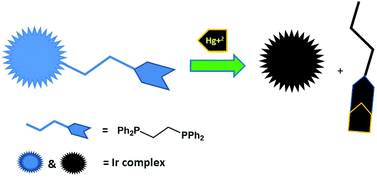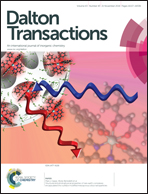New ‘aggregation induced emission (AIE)’ active cyclometalated iridium(iii) based phosphorescent sensors: high sensitivity for mercury(ii) ions†
Abstract
Design and syntheses of ‘aggregation induced emission (AIE)’ active blue-emitting bis-cyclometalated iridium(III) complexes with appended diphosphine ligands [Ir(F2ppy)2(L1/L2)2(Cl)] (F2ppy = 2-(2′,4′-difluoro) phenylpyridine; L1 = 1,2-bis(diphenylphosphino)ethane; L2 = bis(diphenylphosphino)propane) have been realized on a suitable route. The free phosphorous donor atom present on the appended diphosphine is shown to provide selective binding to the mercuric ion (Hg2+). The selective binding ability of the probe molecule towards mercuric ions results in a detectable signal due to complete quenching of their AIE properties. The quenching effect of the probe molecule has been explored and found to be the result of the degradation of the probe iridium(III) complex triggered by the presence of mercuric ions due to an interplay of a soft–soft interaction between the free phosphorous atom of the probe molecule and mercuric ions. These complexes were modelled to obtain deeper understanding of excited state properties and the results were tentatively correlated with the experimental data.


 Please wait while we load your content...
Please wait while we load your content...